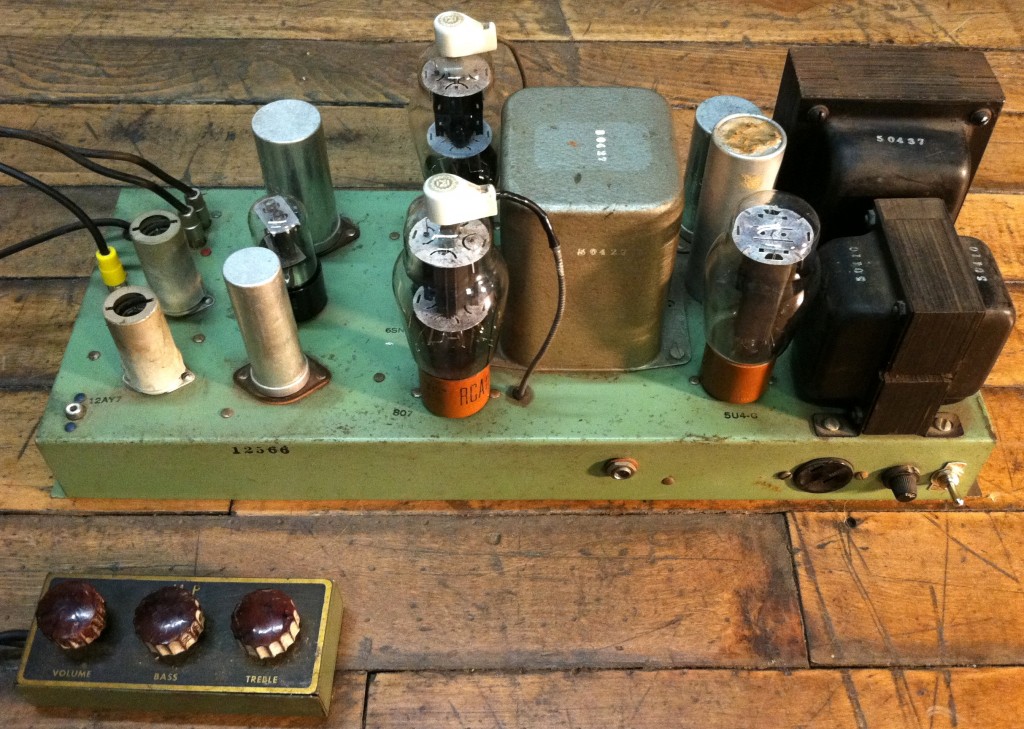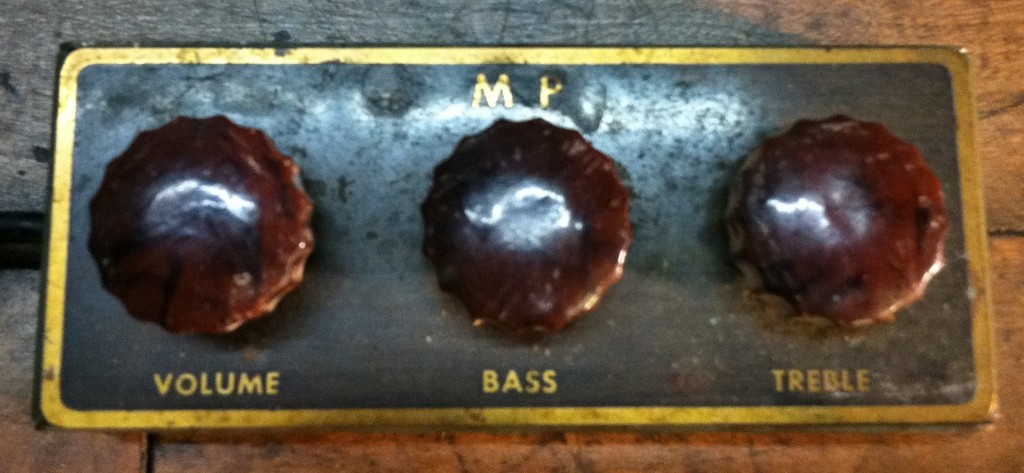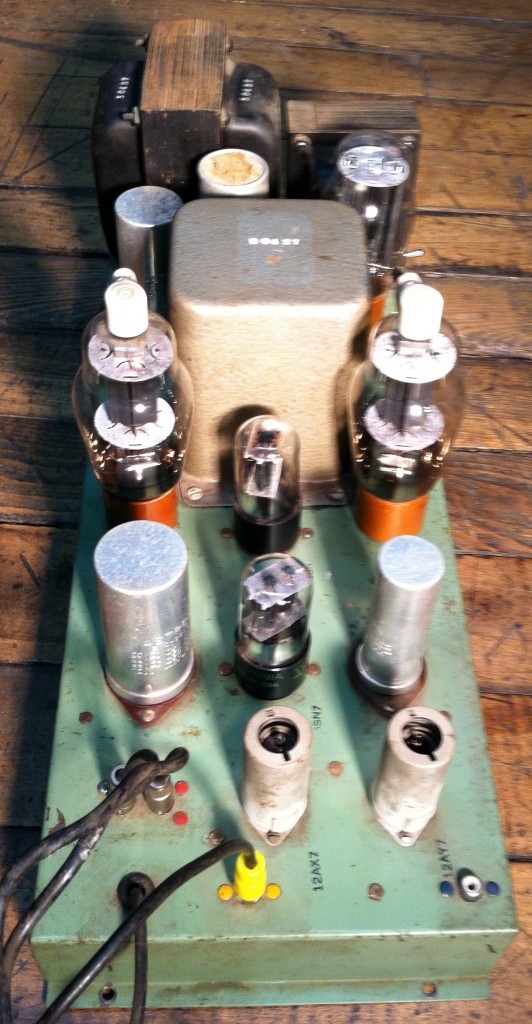 *UPDATE NOV 2016: please read thru the comments section! In all likelihood, this is in fact an original Mirko Paneyko piece, which means I am a huge A-hole for selling this thing for $180 on eBay in 2012. I only learned about MP in 2016 via a huge collection of old journals I purchased. He was a titan in the audio field, and certainly one of the most interesting historical figures in the Bridgeport area in the mid 20th century. Read his NYT obit here. – ED
*UPDATE NOV 2016: please read thru the comments section! In all likelihood, this is in fact an original Mirko Paneyko piece, which means I am a huge A-hole for selling this thing for $180 on eBay in 2012. I only learned about MP in 2016 via a huge collection of old journals I purchased. He was a titan in the audio field, and certainly one of the most interesting historical figures in the Bridgeport area in the mid 20th century. Read his NYT obit here. – ED
I picked up a big pile of old audio equipment this past weekend; notable items included a Shure Level Loc, a massive Bogen tube pa head, a kit-built Acrosound ultralinear 5881 amp, and a Gibson acoustic gtr case from the early ’60s (no gtr). Also included was the mono amplifier shown above. It’s a push-pull amp, cathode biased 807s, with 6SN7 driver and phase inverter; there is also a 2x 12A_7 preamp section with this ‘remote’ control section attached via 10′ of cabling…
 After a little cleaning, the amp actually works fine if I remove the ‘remote’ and input directly into the final 12AX7 stage prior to the phase inverter. As far as actually using the remote, well, I can’t quite figure out what sort of patching needs to be inserted with the two RCA jacks and one RCA male plug coming out of the face of this thing. It’s a little bewildering. If anyone can tell me who made this amplifier, I imagine I could find the schematics somewhere. There are no markings on the unit anywhere besides an inked serial number inside the chassis and the letters ‘MP’ on the remote. I am sure that this is a factory-wired unit, as there is tamper-paint on every solder joint. BTW, I added the on-off-switch and the IEC socket on the side, so don’t let those two details derail your ID’ing efforts. I am guessing that this a circa 1955 unit as the 12AX7 was only introduced in 1953, and the 807 craze was in the process of winding down by ’55… so we’re likely looking at a unit made between 1953 and 1958. Any ideas, please let me know. This thing is 95% of the way to full operation and I’d like to get it running strong again. It’s a tremendous looking piece, and it has a lot of volume.
After a little cleaning, the amp actually works fine if I remove the ‘remote’ and input directly into the final 12AX7 stage prior to the phase inverter. As far as actually using the remote, well, I can’t quite figure out what sort of patching needs to be inserted with the two RCA jacks and one RCA male plug coming out of the face of this thing. It’s a little bewildering. If anyone can tell me who made this amplifier, I imagine I could find the schematics somewhere. There are no markings on the unit anywhere besides an inked serial number inside the chassis and the letters ‘MP’ on the remote. I am sure that this is a factory-wired unit, as there is tamper-paint on every solder joint. BTW, I added the on-off-switch and the IEC socket on the side, so don’t let those two details derail your ID’ing efforts. I am guessing that this a circa 1955 unit as the 12AX7 was only introduced in 1953, and the 807 craze was in the process of winding down by ’55… so we’re likely looking at a unit made between 1953 and 1958. Any ideas, please let me know. This thing is 95% of the way to full operation and I’d like to get it running strong again. It’s a tremendous looking piece, and it has a lot of volume.
*******
***
Updated: the mystery has been solved. This amplifier was built by the Saulnier Music Service of Columbus, Ohio; so sez the son of the man responsible. Read the comments section for the full story. I am still in a need of a schematic (or even just a manual?) for this thing so that I can figure out what do do with the assorted preamp jacks n’plugs. According to our poster, this circuit came from a transformer manual; which would likely mean a Stancor audio-manual circa 1954. Anyone?

12 replies on “Mystery Amp Circa 1955: Mystery Solved. Anyone have a schematic?”
ok, the 3 knob control unit is vintage 1930’s or so. mid to late 30’s. the tube amp is from a different era. these are 2 different manufacturers and don’t belong to one another, unless the knobs are from a different unit and were put on a little later. the knobs look kind of like crosley….very close to a crosley super 11 knob. that would put that to about 1935. much love…
Thanks for the comment Casey. The paint on the two pieces is EXACTLY the same color, though, so i’m inclined to believe they are the same manufacture. you might be right about the knobs though; they appear to be catalin, which was largely phased out by the mid 50s. Anyone else have any ideas?
It probably is out of an installed sound setup made on a semi-custom basis for some household intercom/entertainment vendor. I doubt it’s NuTone or any other biggie. Since it uses 807s they probably bought a bunch surplus.
You probably won’t find docs on it. I wouldn’t lose sleep about parting it out, it certainly isn’t collectible or historic in any sense.
On the East and West Coasts there were dozens of these places. That’s where you get the best buys on the Acro, Peerless and UTC LS iron, buy the whole setup cheaper than the transformer alone on eBay. Most of them are still in the house, often they drywall over the whole setup when they remodel, so they’ll be there until the house is demolished. In the Midwest, most of those outfits bought off the shelf from the catalog houses, because Fair Trade wasn’t so enforced. And the volume was lower, they didn’t have the entire subdivision packed full of similar installs like out East until the seventies-after tubes were gone.
You have a power amp built as part of an in-home installed sound system or a custom console built by my father’s company, Saulnier Music Service of Columbus, Ohio at about the time you suggest. The circuit is out of a transformer manual and the assembly was done by women who moonlighted from their military electronics jobs for my father. I recognize the color and the knobs, which were all Radio Row or state surplus. The color was used on cabinets and walls in sanitariums and the like because it was thought to be the most calming. The knobs were probably twenty years old then.
I know this because we had many 5 gallon pails of that paint we paid good money to have hauled off when we cleaned the house out after he died.
The 807s were used not because they were cheap (although everything else was) but because my father believed plate cap tubes were inherently less failure prone and liable to arc out. A few of these amps had 1625s, which are an 807 with a twelve volt heater, but when the supply of 12 volt heater winding transformers ran out it was cheaper to buy 807s than have a special transformer run done.
Hi Sam. great to hear from you. Would you possibly have a schematic for this item? i’d love to be able to figure out what’s going on with the preamp section. best wishes, c.
wow, the only thing i got right was the age of knobs! ha ha. oh well. very interesting to hear the history behind the amp!
Most of the old transformer catalogs can be found on the Web, but it’s easier and faster to trace them out yourself and draw a schematic.
A great percentage of old consumer electronics were actually variations on “cookbook” design then and now. The cookbooks then were transformer and tube manuals. They all had applications engineers that built circuits and published them.
The interesting electronics are those that WERE NOT cookbook design. McIntosh amplifiers, Tektronix scopes and National, Collins and Racal RF gear.
That isn’t to say cookbook designs are all bad. Most were good in fact.
Probably the best designed audio power amplifier, aside from McIntosh and larger Altecs, was the RCA design found in most later tube manuals and the HF-110 pamphlet. Using an off the shelf output transformer it would better the equivalent McIntosh within the audio band, albeit with higher quiescent power dissipation.
The HF-110 audio booklet has a cover that is quintessential fifties line art and is rare because art types frame them for decoration. It should be reproduced with a two color offset cover on good glossy stock. Someone somewhere has a .pdf but it is pretty crappy looking.
Did you ever get it working?
I agree about the RCA book. Here’s a pdf, but it’s very dull. The original two color cover art is outstanding and would make a great poster today.
~.tubebooks.org/file_downloads/RCA_HiFi.pdf
Chris,
I know this is an old post, but I was wondering if you were ever able to find a schematic of this amp.
Also wondering if you were able to confirm it’s origin. The reason I ask this is because I know of a small company that built equipment almost exactly like the unit you have, but it is not the one Sam has identified.
I hope you are able to view these photos:
https://www.dropbox.com/s/6jn0ly9wzdq41hx/IMG_0125.JPG?dl=0
https://www.dropbox.com/s/255b9ok0wfxxy5x/IMG_0126.JPG?dl=0
https://www.dropbox.com/s/gmxb3yahuosskdy/IMG_0127.JPG?dl=0
As you can see, the similarities are many: the font used for tube labels, the font used on the transformers and on the chassis, the part number range on the chassis, the painted rivets, the 3- pot remote control, the removal of the factory labels from the transformers are ll the same. I can point out several more simularities, but the one that jumps out is the “MP” on the remote. I believe these are the initials of Mr. Mirko Paneyko – founder of MP Engineering Corp. of Fairfield Conn.
I have a fair amount of information on MP Engineering and this certainly looks like their work.
With all due respect to Mr. Sam, I do realize there were many builders and installers back then and I could be incorrect in my train of thought. I just need to bring this to your attention.
Thanks,
Hi Joe. Since I found this amp in fairfield CT, you are likely correct. I sold it long before I had heard of Mirko, and I now regret having done so, as I have read about Mirko in old Journals and he was an incredible engineer and I’d like to have one of his pieces. I bet I will find another, though. CR
Chris,
Thanks for the quick response.
It is too bad you sold that amp, I would love to add it to my modest collection.
I happen to have a few pieces of MP’s gear including (3) televisions, and pair of OTL amplifiers.
https://www.dropbox.com/s/ticncsaanr0al91/2015-12-05%2014.56.06.jpg?dl=0
Above is a photo of a home installation setup by MP Engineering that I bought from a fellow in the Detroit area. It features a pair of 32 ohm speakers with Bozak drivers, a Fisher tuner, and a Dual TT (not original) The console houses a pair of pre-amps with separate DC power supplies that were designed and built by MP.
About 6 months after I acquired this, I was able to locate the matching OTL power amps:
https://www.dropbox.com/s/or1b5m8lswie7mp/IMG_7380.JPG?dl=0
I probably have enough gear and info to do feature on Mirko Paneyko, if you are interested.
Thanks,
Joe Y.
Are you still interested in MP equipment and schematics and the like? I was the executor of Mirko’s estate and I still have some of that.